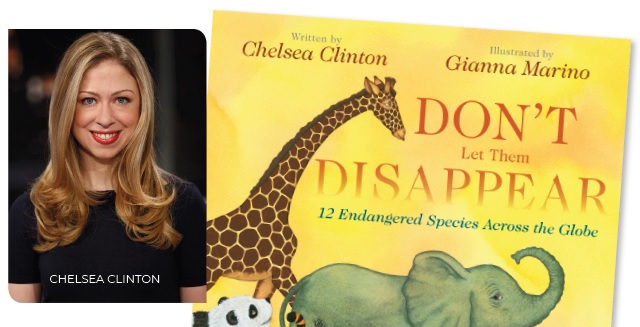The Phoenix Zoo is not the first venue you think of for a book signing, but it was the perfect setting for New York Times bestselling author Chelsea Clinton to talk about her fifth children’s book, Don’t Let Them Disappear: 12 Endangered Species Across the Globe.
The event on April 15 drew a full house and Chelsea’s answers to questions were thoughtful and eloquent. The questions were posed by Executive Vice President of Conservation and Education for the ACNC/Phoenix Zoo Ruth Allard.
She discussed how she chose the 12 animals to feature in the book, and revealed that the elephant is her favorite. Chelsea compared the pachyderm’s maternal nature to the connection she holds to her mother and grandmother.
Prior to her visit to Phoenix, we had a Q&A of our own with Chelsea:
What was the inspiration behind your new book, Don’t Let Them Disappear: 12 Endangered Species Across the Globe?
The most important inspiration is all the kids I’ve spoken to who passionately talk about their love and concern for animals, especially endangered species. As a kid, I also loved animals, especially elephants. I wrote this book for the kids today who care about animals, and because I wish I had this book as a kid.
Now, as an adult, I’ve heard from kids across the country – from kids on my previous book tours, young people in my own life and kids that I spoke to throughout the process for Don’t Let Them Disappear – that our environment and animals are two things they really care about. I think it’s important that as adults we listen to that and help inform and empower them to do something. I’ve also seen the positive impact that young people, even our youngest readers, can have in areas they’re passionate about; for example, in our country during the 1970s, young people played a critical role in saving the bald eagle. I decided to write this book about animals that are deserving of our attention, respect and protection. I hope to inspire and equip young people to do something to save the animals they care about and that are also so vital to our planet.
This is your fifth children’s book. What ages is it geared toward?
As a picture book, it’s written for young readers 4-8, yet I hope it can spark and support conversations in families, classrooms and elsewhere about these endangered animals and others that kids want to help ensure don’t disappear. While I only started my book tour last week, it’s been so exciting to hear from teachers, parents and grandparents who have read Don’t Let Them Disappear with their kids and either learned a fun fact, enjoyed the illustrations or have a new shared cause in saving endangered species.
When and how should parents begin discussions with their children about environmental concerns?
I think that it’s important to start talking to our kids about critical issues from an early age, so that they can start to understand their place in the world, develop their own passions and begin to feel empowered to do something about the issues they care about. Then it is our job as adults to listen to kids talk about what they care about and then help inform and empower them to do something to make a positive difference in the areas that have drawn their focus and passion.
My kids are 2½ and 4½, and we talk about the environment, climate change and, most importantly, what we do in our house to try to make a difference. And while they likely do not yet understand the full scope of why we recycle, my son can help bring out a cardboard box, or my daughter can help us change an energy efficient light bulb (under supervision of course). My hope is that starting these discussions now will lead them to be responsible citizens who care about our planet and want to continue to make a positive impact in whatever ways they can.
What are some ways to get children involved in these causes?
At the end of Don’t Let Them Disappear, I include tips on what young readers and their families can do to help endangered animals such as sharing facts about these precious species and why it’s important never to buy ivory or rhino horn or anything that comes from an endangered species. About how we can support our local zoos and their conversation work and fight climate change and global warming. No action is too small, and you’re never too young to start.
In your last book, Start Now! You Can Make a Difference, you cover topics such as health, hunger and bullying in addition to climate change and endangered species. Is it hard to explain the connections these things share to children, or do they “get it” easier than adults?
All of the issues I write about in my books reflect what I’ve heard from kids and young people – on my book tours, through my work, in my family. I think when we’re young, issues like kindness, health, equity and protecting our planet are clear. And it’s up to us as adults to nurture their passions, help them learn more about the issues, and empower them to do something – and to learn from their clarity.
At what age did you become aware of the various threats to our environment? What was the first action you took?
I remember learning about the elephant poaching crisis in the 1980s and then trying to learn everything I could with my mom and grandmother – from books, our local zoo, conservation organizations, documentaries and more. I was both horrified and devastated that these animals were in danger of going extinct in my lifetime, and I immediately felt like we had to do something to help. From there my passion for animals and protecting our environment grew, and I was fortunate to have adults in my life that supported me in that – from borrowing National Geographic issues from my school library, to subscribing to newsletters thanks to my grandmother to teachers who helped a group of us start a recycling program at our elementary school.
Mazel tov on your pregnancy! You have an interfaith home, you are already practicing tikkun olam, are there other Jewish traditions you observe as a family?
It’s so important to Marc and me that our children grow up with an understanding of both of our faiths. We go to Shabbat services Friday evening, church on Sunday, and practice the traditions that were deeply rooted in our upbringings and remain special in our families and important to us both.
At the end of the event, Chelsea took questions – but only from children. And if the question was similar to the last one asked, it didn’t matter; she answered them all as if that was the most important question asked that night.
It reminded me of a statement she made earlier in the evening, that we should “never talk down to kids” because it is our responsibility to “inform and empower them.”
For more information or Don’t Let Them Disappear: 12 Endangered Species Around the Globe or Chelsea’s other books, visit penguinrandomhouse.com.






